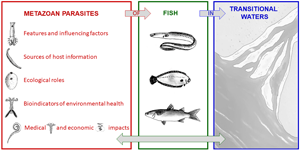Article contents
Ecology and effects of metazoan parasites of fish in transitional waters
Published online by Cambridge University Press: 10 August 2022
Abstract

Given the abundance, heterogeneity and ubiquity of parasitic organisms, understanding how they influence biodiversity, evolution, health and ecosystem functionality is crucial, especially currently when anthropogenic pressures are altering host–parasite balances. This review describes the features, roles and impacts of metazoan parasites of fish occurring in transitional waters (TW). These aquatic ecosystems are highly productive and widespread around the globe and represent most favourable theatres for parasitism given the availability of hosts (invertebrates, fishes and birds) and an increased probability of parasite transmission, especially of those having complex life cycles. Fascinating examples of how parasitism can influence different hierarchical levels of biological systems, from host individuals and populations to entire aquatic communities, through effects on food webs come from this kind of ecosystem. Edible fish of commercial value found in TW can harbour some parasite species, significantly reducing host health, marketability and food safety, with possible economic and public health consequences. Many TW are historically exploited by humans as sources of relevant ecosystem services, including fisheries and aquaculture, and they are highly vulnerable ecosystems. Alteration of TW can be revealed through the study of parasite communities, contributing, as bioindicators, for assessing environmental changes, health and restoration. Fish parasites can provide much information about TW, but this potential appears to be not fully exploited. More studies are necessary to quantify the ecological, economic and medical impacts fish parasites can have on these important ecosystems.
- Type
- Review Article
- Information
- Copyright
- Copyright © The Author(s), 2022. Published by Cambridge University Press
References
- 5
- Cited by





